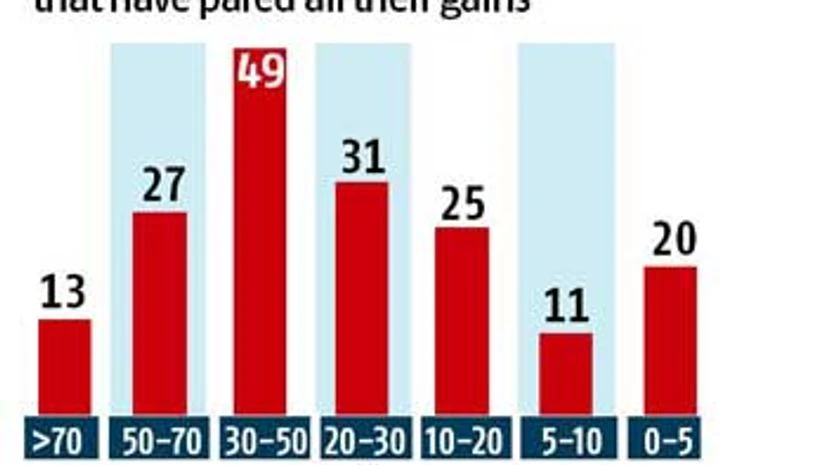The BSE benchmark Sensex seems to be under-reporting the extent of pain gripping the broader market. Nearly a third of the BSE 500 companies (176 stocks) have lost all the gains they made since the Narendra Modi-led government took charge at the Centre on May 26 last year. And, more than 10 per cent (40 of 498 companies) have lost at least half their market value during the past 15 months.
The biggest losers have been infrastructure companies, metal makers, power generators, sugar companies, real estate developers and oil & gas companies, among others. The losses came at a time when, incidentally, infra and capital expenditure-related companies were supposed to be the biggest beneficiaries of the Modi government's infra spending push.
Benchmark indices, however, are still in the green when compared with their levels on May 26 last year. The Sensex has risen 6.8 per cent during the period, while the National Stock Exchange's Nifty is sitting on gains of 8.7 per cent. The rise in the more broad-based BSE 500 is even higher, at 13.2 per cent, thanks to a stronger rally in mid- and small-cap stocks than the large-cap ones.
For example, Bhushan Steel is now down 87.5 per cent from its closing price on May 26 last year. Infra and cement major Jaypee Associates' share price is now at an all-time low, with the firm losing 87 per cent of its value during the past 15 months. It is now trading at Rs 9.73 a share, compared with a closing price of Rs 75.5 on May 26, 2014.
Among other big losers, Unitech is down 79 per cent, Jindal Steel & Power 77 per cent, Amtek Auto 73 per cent, Renuka Sugar 70 per cent, IVRCL 68 per cent, Vedanta 66 per cent, GMR Infra 65 per cent, Adani Power 63 per cent, Reliance Power 61 per cent, GVK Power & Infra 59 per cent, Oriental Bank of Commerce 60 per cent, Cairn India 59 per cent, Reliance Communications 59 per cent, Uco Bank 58 per cent, Reliance Infra 51 per cent, Tata Steel 51 per cent, Hindalco 45 per cent, Tata Power 40 per cent, ONGC 40 per cent, Tata Motors 22 per cent, NTPC 22 per cent, Reliance Industries 21 per cent, Coal India 11 per cent, and ITC five per cent.

Experts attribute this to lower-than-expected economic and corporate growth in last 15 months, besides company-specific issues like high leverage. "There was a bubble in many stocks that led to a big misalignment in their market valuations and underlying fundamentals. This is now getting corrected and the process could go on for some more time if the global financial environment remains choppy," says G Chokkalingam, founder & CEO, Equinomics Research & Advisory.
E-commerce firm Justdial, one the most expensive mid-cap stocks with a price-to-earnings multiple of 80x at the peak, has corrected more than half and declined 36 per cent from its closing price on May 26 last year. Among other richly valued stocks, Symphony is down nearly 30 per cent from its peak, though it is still in the green when compared with its price on May 26, 2014.
Some say a risk-averse approach among investors is taking them to safer bets. "There is a big rush for quality stocks - to companies with debt-free balance sheets and good cash flows. This has led to a polarisation in the valuation that might continue for some time," says Nitin Jain, head of global asset & wealth management group at Edelweiss Capital.
Jain sees pain for mid- and small-cap stocks. "Foreign Institutional Investors (FIIs) largely own the index and large-cap stocks; their selling explains the fall in benchmark indices. Mutual funds and retail investors, however, continue to accumulate mid-caps. If they begin to lose confidence or if MFs face redemption pressure, we can see more pain in non-index stocks," he adds.

)
